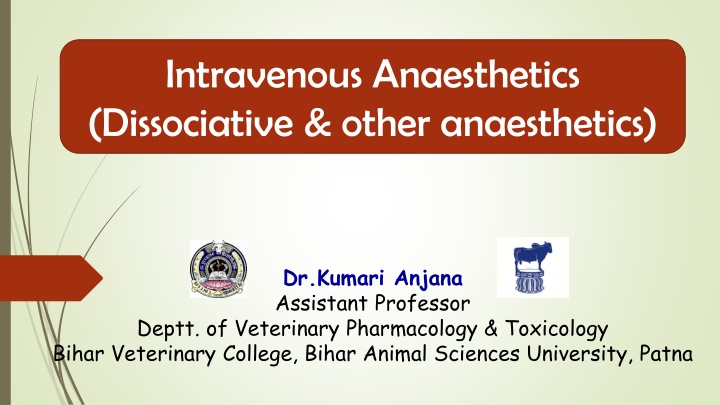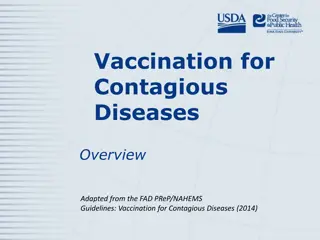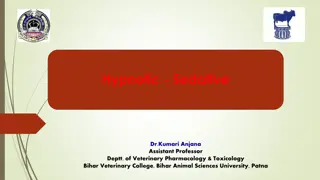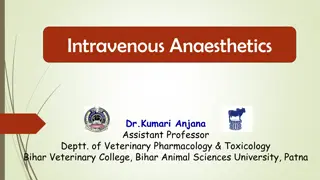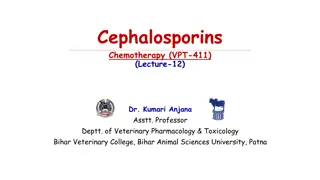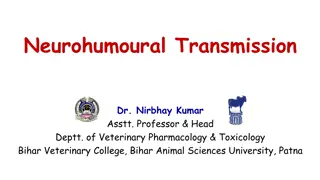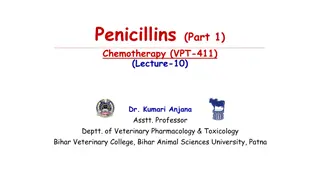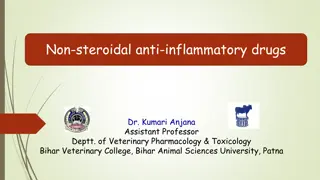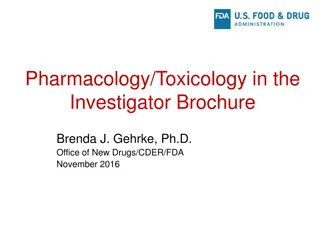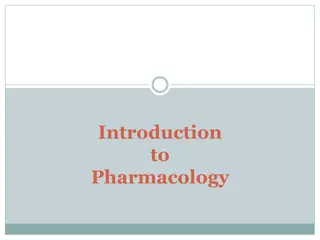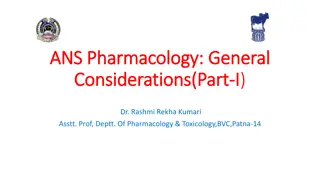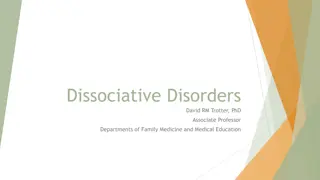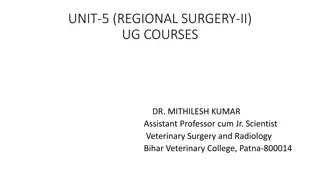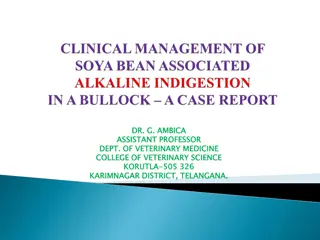Dissociative Anaesthetics in Veterinary Pharmacology
Dissociative anaesthetics induce altered CNS activity, producing sensory loss, analgesia, amnesia, and paralysis without apparent loss of consciousness. Ketamine is a key agent in this class, acting as an NMDA receptor antagonist. It is important for veterinary anaesthesia due to its unique properties and effects on the cardiovascular system.
Download Presentation

Please find below an Image/Link to download the presentation.
The content on the website is provided AS IS for your information and personal use only. It may not be sold, licensed, or shared on other websites without obtaining consent from the author.If you encounter any issues during the download, it is possible that the publisher has removed the file from their server.
You are allowed to download the files provided on this website for personal or commercial use, subject to the condition that they are used lawfully. All files are the property of their respective owners.
The content on the website is provided AS IS for your information and personal use only. It may not be sold, licensed, or shared on other websites without obtaining consent from the author.
E N D
Presentation Transcript
Intravenous Anaesthetics (Dissociative & other anaesthetics) Dr.Kumari Anjana Assistant Professor Deptt. of Veterinary Pharmacology & Toxicology Bihar Veterinary College, Bihar Animal Sciences University, Patna
Dissociative anaesthetics These are the agents that induce a state of altered CNS activity in which the anaesthetised patient feels totally dissociated from its surroundings during induction. These agents produce marked sensory loss, analgesia, amnesia and paralysis of movements without apparent loss of consciousness ( patients appears to be awake but actually is unconsciousness). The term Dissociative anaesthetics is derived primarily from use of ketamine in man and appears to have same meaning in the animals.
Dissociative anaesthetics contd Dissociative anaesthetics- ketamine, tiletamine, Phencyclidine It act as antagonists of excitatory amino acid glutamate( at NMDA type glutamate receptor) and interfere with neuronal transport of 5- HT, dopamine and noradrenaline in CNS. Act on cerebral cortex. At anaesthetic dose no significant effect on respiration, increase in BP and Heart rate due to sympathetic stimulation (can be used in patients in CV). Preanaesthetic diazepam, acepromazine or xylazine administration is necessary before dissociative anaesthesia.
Ketamine It is a general anaesthetic which was first introduced in 1965 for use in humans. In 1970, it was introduced for anaesthesia in the cat. The important features of Ketamine are as below: oIt induces only stage I and II but not III & IV. oIt does not act on ARS (Ascending Reticular System) like other general anaesthetics.
Ketamine contd o It produces depression of thalamoneocortical system and stimulation Therefore, due to dual action, Ketamine is called dissociative anaesthetic. o It induces anaesthesia and amnesia (loss of memory) by functional disruption (dissociation) of CNS through marked CNS excitation. o It produces dissociation or complete unawareness of environment due to amnesia or forgetfulness. of limbic system.
Actions of Ketamine on Cardiovascular System (CVS) Ketamine increases cardiac output, blood pressure, central venous pressure and heart rate. Cardiac stimulatory properties prove it a good induction agent for poor risk and hypovolemic patients. It does not depress respiration, there is profound analgesia and amnesia, muscle relaxation is poor, induction rapid but recovery is prolonged. There is only little salivation which is not a problem, swallowing reflex is impaired. It possesses wide margin of safety i.e. 5 times than that of Pentobarbitone. It can be used in patients with CV shock.
Dosage of Ketamine Dog : As anaesthetic 10 mg/kg IV after diazepam (0.5mg/kg) As restraining -- 10 mg/kg after acepromazine (0.5mg/kg) Horse: 2 mg/kg IV in combination with diazepam (0.2mg/kg) and xylazine (0.1mg/kg) Cattle: induction- 2 mg/kg rapid IV or IV maintenance: 0.2 % ketamine in normal saline solution administered @ 10 ml/min. Goat: 10 mg/kg IV after xylazine (0.2mg/kg)
Phencyclidine Effect on CNS is species specific. Depression in dog and other species. Low doses - Depression High doses convulsion/ excitation. It is used in subhuman primates. Tiletamine It is used with pre-medication of zolazepam (sheep, pigs, horses, dogs & cats).
Steroidal anesthetics- saffan/ Althesin First injectable steroid anaesthetic - hydroxydione Na. Toxicity (thrombophlebitis), its use was discontinued. A Steroidal anaesthetics generally used for induction of anesthesia. It contains two pregnanedions, alphaxalone (steroid I)- alphadolone(steroid II). Produces rapid induction of short duration anaesthesia.
Steroidal anesthetics- saffan/ Althesin contd Althesin is combination of two steroid drugs solubilized in an aqueous formulation containing polyethylated castor oil (Cremophor EL). Alphadolone has less alphaxalone but is included to improve the solubility. Contraindicated not used in dogs due to vehicle surfactant (Cremophor EL) in the preperation causes excessive histamine release from mast cells resulting in profound depression. anaesthetic activity than
Propofol It resembles thiopentone in being highly lipid soluble. It is an oily liquid introduced as 1% emulsion for IV induction and short duration of anesthesia. Quick recovery - rapidly metabolized. No hangover like thiopentone sodium. Etomidate Has potent hypnotic effect but no analgesic effect. Has wide margin of safety. No hangover like thiopentone sodium.
Metomidate It is recommonded for anesthesia in birds. Also in pig, dog & cats. Has wide margin of safety. No hangover like thiopentone sodium Urethane Also called Ethyl carbamate. Chemically related to urea. Commonly used in laboratory animals.
Chloralose It is the condensation product of glucose and chloralhydrate. it is transformed to chloraldehyde which is further metabolized to trichloroethanol. Produces dissociative anaesthesia like Ketamine. Midazolam A benzodiazepines derivatives with slower onset of anesthetic action. It has no respiratory or cardiovascular depressant effect. In human it is generally used as a preoperative sedative for endoscopy or other probing procedures.
